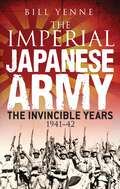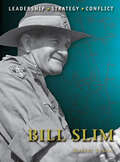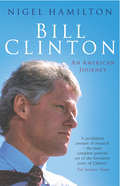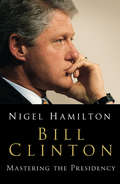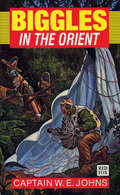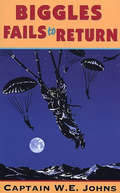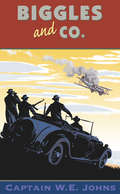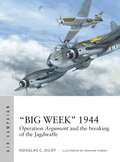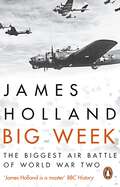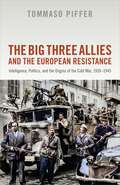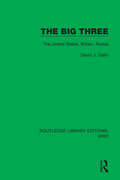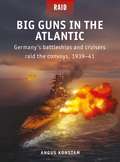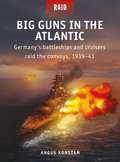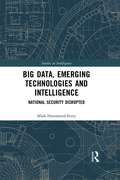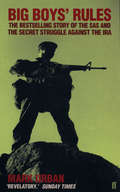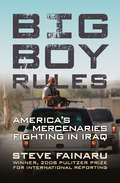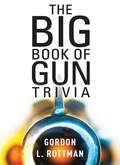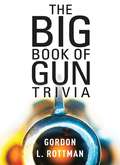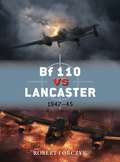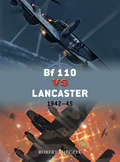- Table View
- List View
Bill Yenne the Imperial Japanese Army: The Invincible Years 1941-42
by Bill YenneThe German offensives which crushed Poland in 1939 and swallowed most of Western Europe in less than two months in 1940 have been well documented and heavily studied, however, the overall picture of the remarkable Japanese offensive land campaign in 1941–42 has received less attention. In this fascinating new book, Bill Yenne documents the years when the Imperial Japanese Army (IJA) was conducting its equally unstoppable ground campaign in the Far East, and unlike other books on this subject, he studies the campaign from the Japanese point of view. He reveals how the IJA were able to conquer huge swathes of Southeast Asia in a little over eight weeks after the attack on Pearl Harbor. Using first-hand accounts from Japanese sources, Yenne reveals the tactics and mindset of the IJA during their offensive, detailing the capturing of Manila, the Philippines, Hong Kong, Singapore, Burma, and the Dutch East Indies. Exploring the infrastructure and technical challenges of waging war across such a huge area, Yenne delves into the hardships that faced individual Japanese soldiers in theatre and explains how the Japanese were able to remain undefeated and establish the aura of invincibility that marked their campaign between 1941–42.
Bill Slim: The Background, Strategies, Tactics And Battlefield Experiences Of The Greatest Commanders Of History (Command #17)
by Robert LymanBill' Slim was one of the greatest British generals of World War II. In a career that stretched from 1914 until 1958, Bill Slim's greatest triumphs came in India and Burma in the long war against the Japanese. Thrust into a desperate situation, he orchestrated the longest retreat in British Army history in the withdrawal from Burma. He then turned on the Japanese in India, shattered their army, and pursued them to destruction. Apart from his great military victories, Slim also left a legacy of training and morale building that endures in the British Army to this day. This book examines both Bill Slim's military career and his place in military history by examining some of his greatest battles and the strategy and tactics that set him apart from his contemporaries.
Bill Clinton: An American Journey
by Nigel HamiltonNigel Hamilton brings all the magisterial authority he brought to his Whitbread-winning biography of Monty, and all the talent for tracking down and verifying hidden, controversial material that he showed in JFK: Reckless Youth, which topped the American bestseller charts for months, in this new biography of Bill Clinton. Born into a 'white trash' family in backwoods, racially segregated Arkansas, he suffered under an alcoholic, violent stepfather, on one occasion having to fight him physically in order to protect his mother. As a youth he would become inspired by the civil rights movement, particularly Martin Luther King, and as a student became a long-haired hippy musician, involved in radical politics and also discovering free love. Hamilton tells the story of how Clinton's sexual and political career developed hand in hand. This is a book about sexual politics on many levels, showing how Clinton's life was formed by changing attitudes. Here is a man who, far from being a sexual predator or exploiter of his position - like JFK - was swept to power because women adored him, whether Democratic party helpers, the women of the American electorate - or indeed Hilary Clinton, whose powerfully manipulative personality is shown to have been vital to his success,. Clinton has been polygamous throughout his adult life, and Hamilton's fascinating portrait of a marriage examines Hilary's relationship with his quite astonishing number of girlfriends. The book also covers his time at Oxford as a Rhodes scholar, his political apprenticeship and his rise to power, culminating in his election as President in '92.
Bill Clinton: Mastering the Presidency
by Nigel HamiltonNigel Hamilton's account of Bill Clinton's early life and career - Bill Clinton: An American Journey - drew widespread praise. Now, in Bill Clinton: Mastering the Presidency, Nigel Hamilton charts the experience of the 42nd President as he took presidential oath of office- and how he fared therafter in the piranha pool of Washington D.C.Hamilton charts what was possibly the greatest disaster and re-reinvention of a president in office in modern times. How Bill Clinton faced up to his failures, and refashioned himself in the White House is an epic story. With a thriving U.S. economy and hard-won wisdom in international affairs and in combating the rise of terrorism, Clinton would begin his second term as the undisputed, immensely popular leader of the Western world - aware, however, that terrors ant treason within America loomed as large as dangers abroad.Insightful, balanced, prodigiously researched and a joy to read, Bill Clinton: Mastering the Presidency is set to become, alongside its prequel, the classic story of Clinton's extraordinary effort to be a modern president, in a modern world-and a chronicle one of the most extraordinary reversals of fortune in modern American politics.
Bildungsangebote zu Nationalsozialismus und Holocaust: Eine empirische Studie zu Reaktionen von Jugendlichen zum pädagogischen Umgang (Holocaust Education – Historisches Lernen – Menschenrechtsbildung)
by Christina UlbrichtChristina Ulbricht untersucht, wie Jugendliche auf unterschiedliche Bildungsangebote zu NS-Verbrechen und Holocaust reagieren. Hierfür befragte sie insgesamt 32 Jugendliche mithilfe leitfadengestützter Interviews zu ihren inner- und außerschulischen Erfahrungen mit diesen Themen sowie zu besuchten Bildungsangeboten. Darüber hinaus hat die Autorin in einem explorativen Vorgehen vor allem Jugendliche aus Bayern in ihrer Auseinandersetzung mit einer KZ-Gedenkstätte beobachtet. Die Auswertung des Datenmaterials mithilfe der ermöglicht unter anderem eine interdisziplinäre Diskussion zur Entwicklung neuer Bildungsangebote, die dem Umstand Rechnung trägt, dass aufgrund der zeitlichen Distanz lediglich mit medialen Verarbeitungen der Überlieferungen von Zeitzeuginnen und Zeitzeugen gearbeitet werden kann.
Biggles in the Orient
by W E Johns'You're out last hope, Bigglesworth,' said the Air Commodore, with something like despair in his voice.The war supply route between Calcutta and China is a vital one but something is attacking the planes that fly it. Again and again pilots set off, only to disappear somewhere along the line, never to be seen again. When Biggles and his team are called in to investigatem, flying the route is close to a suicide mission . . .
Biggles Fails to Return (Biggles #14)
by W E Johns'It is my opinion that Biggles is dead,' asserted the Air Commodore.'I had already sensed that, Sir, but I don't believe it,' retorted Algy.When Biggles undertakes a lone mission to rescue an Italian princess from Mussolini's Italy he doesn't know he's walking into a trap. Against all the odds he gets the princess to the aircraft ready to fly them back to safety, but he never reaches the plane. He's last seen wounded and surrounded by the enemy, but Algy, Ginger and Bertie refuse to accept that he's dead until they see the evidence themselves.
Biggles and Co (Biggles #10)
by W E Johns'Now Listen, Bigglesworth; I'll tell you what I'm prepared to do, and you can please yourself what you do about it. Run this gang of crooks to earth, or point out to me the man that is at the head of it - or the chief operator in this country - and I'll make you a present of a cheque for ten thousand pounds.'Colonel Raymond from Intelligence persuades Biggles, Algy and Ginger to take on the challenge of transporting gold bullion and diamonds to France. Every other firm which has taken the job has failed and the gold has been stolen, the planes crashed or disappeared and the pilots have lost their lives. Biggles comes up with daring scheme after daring scheme, but then Algy is captured and held to ransom and Biggles finds that he's up against his old enemy - Von Stalhein
“Big Week” 1944: Operation Argument and the breaking of the Jagdwaffe (Air Campaign)
by Douglas C. DildyA rigorous new analysis of America's legendary 'Big Week' air campaign which enabled the Allies to gain air superiority before D-Day.The USAAF's mighty World War II bomber forces were designed for unescorted, precision daylight bombing, but no-one foresaw the devastation that German radar-directed interceptors would inflict on them. Following the failures of 1943's Schweinfurt-Regensburg raids, and with D-Day looming, the Allies urgently needed to crush the Luftwaffe's ability to oppose the landings.In February 1944, the Allies conceived and fought history's first-ever successful offensive counterair (OCA) campaign, Operation Argument or “Big Week.” Attacking German aircraft factories with hundreds of heavy bombers, escorted by the new long-range P-51 Mustang, it aimed both to slash aircraft production and force the Luftwaffe into combat, allowing the new Mustangs to take their toll on the German interceptors. This expertly written, illustration-packed account explains how the Allies finally began to win air superiority over Europe, and how Operation Argument marked the beginning of the Luftwaffe's fall.
Big Week: The Biggest Air Battle of World War Two
by James Holland'James Holland is a master' BBC HistoryIt was to be the battle to end the air war once and for all . . .During the third week of February 1944, the combined Allied air forces based in Britain and Italy launched their first-ever round-the-clock bomber offensive against Germany. The aim was to smash the main factories and production centres of the Luftwaffe and at the same time draw the German fighter force up into the air and into battle. Officially called Operation ARGUMENT, this monumental air assault was very quickly became known simply as Big Week.In the six months up to its launch, for the Allies, the bomber war was not turning out as planned. Raids by the US Eighth Air Force and the RAF deep into Germany were being decimated and falling far short of its purpose. With D-Day drawing ever-closer, that was a massive problem. The Allies needed clear skies to invade. The clock was ticking inexorably.Yet the Luftwaffe was also in crisis. Short of resources, of fuel, and on properly trained pilots, the strain on those still flying was immense, their losses severe. And despite the chaos of their leadership, they were achieving far more than should have been reasonably expected against the superior numbers of the Allied planes.Big Week is the knife-edged story of bomber against flak gun and fighter, but also, crucially, fighter against fighter, as the stakes rose higher and higher. Following the fortunes of pilots, aircrew and civilians from both sides, this is a blistering narrative of one of the most critical periods of the entire war, one that culminated in the largest air battle ever witnessed. It is also one that has been largely forgotten, but which has been brilliantly brought back to life by award-winning historian, James Holland.
The Big Three Allies and the European Resistance: Intelligence, Politics, and the Origins of the Cold War, 1939-1945
by Tommaso PifferWhile the Big Three and their continental Allies fought against Nazi Germany, another war was under way on the continent: the war to shape the political landscape of post-war Europe. In the Balkans, the war overlapped with political and ethnic conflicts, engulfing the region in bloody civil wars. In Central and Eastern Europe, partisan movements engaged the Germans without losing sight of the danger posed by the arrival of the Red Army. In France and in Italy, the adoption of the slogans of national liberation provided the communist parties with a formidable democratic legitimacy, which established them as key players in the political lives of their countries. The British and the Americans worked to stir up, support, control, and direct these resistance groups. London created the Special Operations Executive (SOE) and Washington the Office of Strategic Services (OSS), both of whom sent agents into occupied Europe to liaise directly with the guerilla groups. Through the Comintern, Moscow carefully coordinated the actions of the European communist parties with the foreign policy of the Soviet Union, which was acting for the first time as a key player in the arena of international relations. The forests and the mountains where the partisans were fighting the Germans soon became a major part of the proxy war that the Big Three waged to shift the post-war geopolitical balance in their favour. Looking for the first time at the Big Three in a comparative study and spanning Europe from Yugoslavia to Poland, from Greece to France and Italy, this book vividly depicts and sharply analyses how this proxy war shaped the history of the post-war settlement. In so doing, Piffer deftly connects high political histories with history from below, making the book important reading for all those interested in the history of the war and cold war, communism and Resistance, and diplomacy and intelligence.
The Big Three: The United States, Britain, Russia (Routledge Library Editions: WW2 #2)
by David J. DallinThis book, first published in 1946, analyses the state of the world at the close of the Second World War. Global power was passing from Britain to the United States and the Soviet Union, with the US being involved in every part of the world, Russia dominant in eastern Europe and the world looked a very uncertain place. This survey of the main three powers examines their changing conditions and foreign policies.
The Big Three: The United States, Britain, Russia (Routledge Library Editions: WW2 #2)
by David J. DallinThis book, first published in 1946, analyses the state of the world at the close of the Second World War. Global power was passing from Britain to the United States and the Soviet Union, with the US being involved in every part of the world, Russia dominant in eastern Europe and the world looked a very uncertain place. This survey of the main three powers examines their changing conditions and foreign policies.
Big Lies in a Small Town: A Novel
by Diane Chamberlain‘Fans of Jodi Picoult’s style will love how Diane Chamberlain writes’ CandisBig Lies in a Small Town, by the internationally bestselling author Diane Chamberlain, is a sweeping novel about two women connected by a painting that holds many dark secrets.North Carolina, 2018: Morgan Christopher’s life has been derailed. Taking the fall for a crime she did not commit, she finds herself serving a three-year stint in the North Carolina Women’s Correctional Centre. Her dream of a career in the arts is put on hold – until a mysterious visitor makes her an offer that will see her released immediately. Her assignment: restore an old post office mural in a sleepy southern town. Morgan knows nothing about art restoration but, desperate to leave prison, she accepts. What she finds under the layers of grime is a painting that tells the story of madness, violence and a conspiracy of small-town secrets.North Carolina, 1940: Anna Dale, an artist from New Jersey, wins a national contest to paint a mural for the post office in Edenton, North Carolina. Alone in the world and desperate for work, she accepts. But what she doesn’t expect is to find herself immersed in a town where prejudices run deep, where people are hiding secrets behind closed doors and where the price for being different might just end in murder.What happened to Anna Dale? Are the clues hidden in the decrepit mural? Can Morgan overcome her own demons to discover what exists beneath the layers of lies?
Big Guns in the Atlantic: Germany’s battleships and cruisers raid the convoys, 1939–41 (Raid)
by Angus KonstamAt the outbreak of World War II the German Kriegsmarine still had a relatively small U-boat arm. To reach Britain's convoy routes in the North Atlantic, these boats had to pass around the top of the British Isles - a long and dangerous voyage to their "hunting grounds". Germany's larger surface warships were much better suited to this kind of long-range operation. So, during late 1939 the armoured cruiser Deutschland, and later the battlecruisers Scharnhorst and Gneisenau were used as commerce raiders, to strike at Allied convoys in the North Atlantic. These sorties met with mixed results, but for Germany's naval high command they showed that this kind of operation had potential. Then, the fall of France, Denmark and Norway in early 1940 dramatically altered the strategic situation. The Atlantic was now far easier to reach, and to escape from. During 1940, further moderately successful sorties were made by the cruisers Admiral Scheer and Admiral Hipper. By the end of the year, with British mercantile losses mounting to surface raiders and U-Boats, plans were developed for a much larger raid, first using both cruisers, and then the two battlecruisers. The climax of this was Operation Berlin, the Kriegsmarine's largest and most wide-ranging North Atlantic sortie so far. Scharnhorst and Gneisenau remained at sea for two months, destroying 22 Allied merchant ships, and severely disrupting Britain's lifeline convoys. So, when the operation ended, the German commander, Admiral Lütjens was ordered to repeat his success - this time with the brand new battleship Bismarck. The rest, as they say, is history. These earlier Atlantic raids demonstrated that German surface ships could be highly effective commerce raiders. For those willing to see though, they also demonstrated just how risky this strategy could be. Covering a fascinating and detailed analysis of the Kriegsmarine's Atlantic raids between 1939 and 1941, this book will appeal to readers interested in World War II and in particular in Germany's naval operations.
Big Guns in the Atlantic: Germany’s battleships and cruisers raid the convoys, 1939–41 (Raid)
by Angus KonstamAt the outbreak of World War II the German Kriegsmarine still had a relatively small U-boat arm. To reach Britain's convoy routes in the North Atlantic, these boats had to pass around the top of the British Isles - a long and dangerous voyage to their "hunting grounds". Germany's larger surface warships were much better suited to this kind of long-range operation. So, during late 1939 the armoured cruiser Deutschland, and later the battlecruisers Scharnhorst and Gneisenau were used as commerce raiders, to strike at Allied convoys in the North Atlantic. These sorties met with mixed results, but for Germany's naval high command they showed that this kind of operation had potential. Then, the fall of France, Denmark and Norway in early 1940 dramatically altered the strategic situation. The Atlantic was now far easier to reach, and to escape from. During 1940, further moderately successful sorties were made by the cruisers Admiral Scheer and Admiral Hipper. By the end of the year, with British mercantile losses mounting to surface raiders and U-Boats, plans were developed for a much larger raid, first using both cruisers, and then the two battlecruisers. The climax of this was Operation Berlin, the Kriegsmarine's largest and most wide-ranging North Atlantic sortie so far. Scharnhorst and Gneisenau remained at sea for two months, destroying 22 Allied merchant ships, and severely disrupting Britain's lifeline convoys. So, when the operation ended, the German commander, Admiral Lütjens was ordered to repeat his success - this time with the brand new battleship Bismarck. The rest, as they say, is history. These earlier Atlantic raids demonstrated that German surface ships could be highly effective commerce raiders. For those willing to see though, they also demonstrated just how risky this strategy could be. Covering a fascinating and detailed analysis of the Kriegsmarine's Atlantic raids between 1939 and 1941, this book will appeal to readers interested in World War II and in particular in Germany's naval operations.
Big Dreams for the West End Girls (The West End Girls #2)
by Elaine RobertsNothing will stop her – not even the war!1914. Working in a bustling café on London's Shaftesbury Avenue, Joyce Taylor dreams of opening her own restaurant. But when the man she loves enlists in the war, and a surprise request comes through from her dying grandmother, Joyce's life gets turned upside down.Struggling to keep the café afloat with her new-found responsibilities, it's not long before Joyce starts to feel the pressure might be all too much. Luckily, her supportive friends Annie and Rose are on hand to help. Despite all the madness, can Joyce find a way to make her dreams come true? And will her love story have a happy ending?Annie, Rose and Joyce are three girls with very different dreams – but the same great friendship. From the author of the Foyles Bookshop series, Big Dreams for the West End Girls is a charming and uplifting WW1 saga, perfect for fans of Daisy Styles and Rosie Hendry.What readers are saying about Big Dreams for the West End Girls:'Exceptional reading! You will need tissues' 5 stars'Truly inspiring historical fiction. A lovely written piece of work! Readers will not be disappointed with this one! I loved every minute. My heart is with all of the characters' 5 stars'A heartwarming, historical novel with strong characters and lots of plot turns and twists''I highly recommend this book for its fascinating historical details and strong main character''An excellent WWI-era historical fiction saga that I really, truly enjoyed' 5 stars'One does not have to read the previous book to easily follow along and pick up the gem that is this novel' 5 stars'Well Elaine you have done it again! The first book was brilliant and this has just got better. I still feel like I am one of the girls! I can't wait to read the next in the series' 5 stars
Big Data, Emerging Technologies and Intelligence: National Security Disrupted (Studies in Intelligence)
by Miah Hammond-ErreyThis book sets out the big data landscape, comprising data abundance, digital connectivity and ubiquitous technology, and shows how the big data landscape and the emerging technologies it fuels are impacting national security.This book illustrates that big data is transforming intelligence production as well as changing the national security environment broadly, including what is considered a part of national security as well as the relationships agencies have with the public. The book highlights the impact of big data on intelligence production and national security from the perspective of Australian national security leaders and practitioners, and the research is based on empirical data collection, with insights from nearly 50 participants from within Australia’s National Intelligence Community. It argues that big data is transforming intelligence and national security and shows that the impacts of big data on the knowledge, activities and organisation of intelligence agencies is challenging some foundational intelligence principles, including the distinction between foreign and domestic intelligence collection. Furthermore, the book argues that big data has created emerging threats to national security; for example, it enables invasive targeting and surveillance, drives information warfare as well as social and political interference, and challenges the existing models of harm assessment used in national security. The book maps broad areas of change for intelligence agencies in the national security context and what they mean for intelligence communities, and explores how intelligence agencies look out to the rest of society, considering specific impacts relating to privacy, ethics and trust.This book will be of much interest to students of intelligence studies, technology studies, national security and International Relations.
Big Data, Emerging Technologies and Intelligence: National Security Disrupted (Studies in Intelligence)
by Miah Hammond-ErreyThis book sets out the big data landscape, comprising data abundance, digital connectivity and ubiquitous technology, and shows how the big data landscape and the emerging technologies it fuels are impacting national security.This book illustrates that big data is transforming intelligence production as well as changing the national security environment broadly, including what is considered a part of national security as well as the relationships agencies have with the public. The book highlights the impact of big data on intelligence production and national security from the perspective of Australian national security leaders and practitioners, and the research is based on empirical data collection, with insights from nearly 50 participants from within Australia’s National Intelligence Community. It argues that big data is transforming intelligence and national security and shows that the impacts of big data on the knowledge, activities and organisation of intelligence agencies is challenging some foundational intelligence principles, including the distinction between foreign and domestic intelligence collection. Furthermore, the book argues that big data has created emerging threats to national security; for example, it enables invasive targeting and surveillance, drives information warfare as well as social and political interference, and challenges the existing models of harm assessment used in national security. The book maps broad areas of change for intelligence agencies in the national security context and what they mean for intelligence communities, and explores how intelligence agencies look out to the rest of society, considering specific impacts relating to privacy, ethics and trust.This book will be of much interest to students of intelligence studies, technology studies, national security and International Relations.
Big Boys' Rules: The SAS and the Secret Struggle Against the IRA
by Mark UrbanThe SAS describes its attitude to the use of lethal force as 'Big boys' games, big boys' rules'. Anyone caught with a gun or bomb can expect to be shot. In Big Boys' Rules: The SAS and the Secret Struggle Against the IRA Mark Urban meticulously explores the security forces' covert operations in Northern Ireland: from the mid-1970s, when they were stepped up, to the Loughall ambush in 1987, in which eight IRA Provisionals were killed. While charting the successes and failures of special operations during the troubles, Urban reveals the unenviable dilemmas faced by intelligence chiefs engaged in a daily struggle against one of the world's most sophisticated terrorist organisations.'This is a book that needed to be written and which fulfils the essentials of any Ulster story; it expands understanding beyond fragmented jingoism and newspaper headlines.' John Stalker, Sunday Times
Big Boy Rules: America's Mercenaries Fighting in Iraq
by Steve FainaruThere are tens of thousands of them in Iraq. They work for companies with exotic and ominous-sounding names, like Crescent Security Group, Triple Canopy, and Blackwater Worldwide. They travel in convoys of multicolored pickups fortified with makeshift armor, belt-fed machine guns, frag grenades, and even shoulder-fired missiles. They protect everything from the U.S. ambassador and American generals to shipments of Frappuccino bound for Baghdad&’s Green Zone. They kill Iraqis, and Iraqis kill them. And the only law they recognize is Big Boy Rules. From a Pulitzer Prize–winning reporter comes a harrowing journey into Iraq&’s parallel war. Part MadMax, part Fight Club, it is a world filled with &“private security contractors&”—the U.S. government&’s sanitized name for tens of thousands of modern mercenaries, or mercs, who roam Iraq with impunity, doing jobs that the overstretched and understaffed military can&’t or won&’t do. They are men like Jon Coté, a sensitive former U.S. army paratrooper and University of Florida fraternity brother who realizes too late that he made a terrible mistake coming back to Iraq. And Paul Reuben, a friendly security company medic who has no formal medical training and lacks basic supplies, like tourniquets. They are part of America&’s &“other&” army—some patriotic, some desperate, some just out for cash or adventure. And some who disappear into the void that is Iraq and are never seen again.Washington Post reporter Steve Fainaru traveled with a group of private security contractors to find out what motivates them to put their lives in danger every day. He joined Jon Coté and the men of Crescent Security Group as they made their way through Iraq—armed to the teeth, dodging not only bombs and insurgents but also their own Iraqi colleagues. Just days after Fainaru left to go home, five men of Crescent Security Group were kidnapped in broad daylight on Iraq&’s main highway. How the government and the company responded reveals the dark truths behind the largest private force in the history of American warfare. . . . With 16 pages of photographs
The Big Book of Gun Trivia: Everything you want to know, don’t want to know, and don’t know you need to know
by Gordon L. RottmanA complete guide to weapons history, facts, myths and trivia, covering everything you wanted to know, didn't want to know and you don't know you need to know... Gordon Rottman offers a step by step guide through interesting weapon facts and statistics, including a section on ammunition, while breaking apart popular myths and misconceptions. Covering subjects from weapons designations to the longest serving military rifles, where rifles get their names from and everything in between, Osprey is proud to present The Big Book of Gun Trivia.
The Big Book of Gun Trivia: Everything you want to know, don’t want to know, and don’t know you need to know
by Gordon L. RottmanA complete guide to weapons history, facts, myths and trivia, covering everything you wanted to know, didn't want to know and you don't know you need to know... Gordon Rottman offers a step by step guide through interesting weapon facts and statistics, including a section on ammunition, while breaking apart popular myths and misconceptions. Covering subjects from weapons designations to the longest serving military rifles, where rifles get their names from and everything in between, Osprey is proud to present The Big Book of Gun Trivia.
Bf 110 vs Lancaster: 1942–45 (Duel)
by Jim Laurier Robert Forczyk Gareth HectorThe RAF introduced the Avro Lancaster in 1942 and used it to spearhead this aerial offensive. In response, the Luftwaffe created an elite nightfighter force based primarily upon the Bf 110. The Luftwaffe was quick to equip it with airborne radar that allowed it to intercept and destroy Lancasters over Germany. In turn, the RAF adopted countermeasures such as the Monica rearward-looking radar to alert Lancaster crews to the approach of nightfighters. In May 1943 the Luftwaffe suddenly developed a novel technical and tactical approach to attacking RAF bombers. The new tactic proved amazingly successful, and British bombers could be attacked from below with no warning. For its part, the RAF failed to detect the new German tactic for six crucial months, during which time its Lancaster bombers were almost defenceless against this new threat. In time, however, the German advantage of surprise was lost and the RAF developed countermeasures to deal with the new threat. The duel between upgraded Bf 110s and Lancasters in the night skies over Germany became increasingly dominated by cutting-edge technology, which would determine the efficacy of strategic bombing.
Bf 110 vs Lancaster: 1942–45 (Duel #51)
by Jim Laurier Robert Forczyk Gareth HectorThe RAF introduced the Avro Lancaster in 1942 and used it to spearhead this aerial offensive. In response, the Luftwaffe created an elite nightfighter force based primarily upon the Bf 110. The Luftwaffe was quick to equip it with airborne radar that allowed it to intercept and destroy Lancasters over Germany. In turn, the RAF adopted countermeasures such as the Monica rearward-looking radar to alert Lancaster crews to the approach of nightfighters. In May 1943 the Luftwaffe suddenly developed a novel technical and tactical approach to attacking RAF bombers. The new tactic proved amazingly successful, and British bombers could be attacked from below with no warning. For its part, the RAF failed to detect the new German tactic for six crucial months, during which time its Lancaster bombers were almost defenceless against this new threat. In time, however, the German advantage of surprise was lost and the RAF developed countermeasures to deal with the new threat. The duel between upgraded Bf 110s and Lancasters in the night skies over Germany became increasingly dominated by cutting-edge technology, which would determine the efficacy of strategic bombing.
